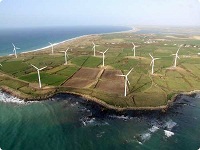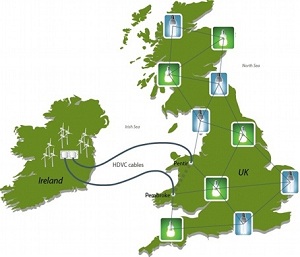Ireland's Growing Potential in Wind Energy
 For a nation battling double digit unemployment and near total dependency on imported fossil fuels to meet its energy needs, the growing job creation potential of renewable energy in Ireland is like a breath of fresh air.
For a nation battling double digit unemployment and near total dependency on imported fossil fuels to meet its energy needs, the growing job creation potential of renewable energy in Ireland is like a breath of fresh air.The Irish government has been battling growing unemployment for the last five years - currently at 14.8 percent - while at the same time seeking ways to lower the country’s carbon emissions to meet the reduction target of 20 percent set by the European Union.
The Irish renewable energy sector is starting to demonstrate its potential to create new jobs and more sustainable energy, according to the Irish Wind and Energy Association (IWEA).
During its recent annual fall meeting in Killarney, Ireland, the Association estimated the Irish renewable energy sector could create 30,000 new jobs by 2020, but only if the government instituted policy changes targeting a higher share of renewables in the national energy mix.
Roughly 90 percent of the island’s energy supply is currently derived from imported fossil fuels, making it the least self-sufficient industrialized economy in this respect.
The most promising area for employment growth is the wind energy sector, which has been proven to be highly efficient due to the island’s location and geography. Ireland is the best location for wind power generation in Europe due to its exposure to high winds from the Atlantic Ocean and the Irish Sea.
While already among the top ten producers of wind energy in Europe, Ireland has enough resources to supply not only a much larger part of its own energy needs, but also the needs of other European countries, most notably the UK.
Wind energy in Ireland has seen substantial growth in the last fifteen years. In the last year alone, wind energy generating capacity increased by 17 percent and almost doubled between 2002 and 2011. Around 19 percent of electricity supply is via renewable generation, of which 15.6 percent is wind, the International Energy Agency reports.
Wind energy dominates the Irish renewable energy market which makes it an important tool for reaching its own goal of 40 percent of electricity demand from renewable energy sources by 2020.
The IEA estimates that Irish wind energy can exceed this goal and has the potential to generate enough wind sourced electricity to meet more than the domestic demand by 2030. In addition, the potential economic value of electricity generated by wind could reach almost 15 billion EUR (19 billion USD) by 2050.
The Sustainable Energy Authority of Ireland is developing a template for local authority renewable energy strategies. An important part of the project will be the strategy for wind energy.
According to the IEA, “the ultimate aim is to develop consistency nationally across all the local authorities” and to “identify initiatives and next steps to progress this issue with a broad range of stakeholders.”
According to theIEA’s Wind Energy 2011 Annual Report, the wind energy sector alone could create 20,000 new jobs by 2040.
Ireland is a Trading Nation
Despite its dependency on foreign sourced fossil fuels, the Irish Republic is one of the top five international economies in the world. Its high level of trade in the food and minerals sectors has helped sustain continued foreign investors interest even during the recession. The US is the leading foreign investor in the Irish economy.
Both of these factors are supporting the country’s slow recovery from the recession. But in the long run they will not be the main factors leading to increased job creation.
 While job creation is one of the Irish government’s top priorities, its economic action plans to date have not explicitly pointed to the employment potential of the renewable energy sector even though other major national economies and the International Energy Agency (IEA)have gone on record in promoting the sector’s possibilities.
While job creation is one of the Irish government’s top priorities, its economic action plans to date have not explicitly pointed to the employment potential of the renewable energy sector even though other major national economies and the International Energy Agency (IEA)have gone on record in promoting the sector’s possibilities.The Association suggests an export goal of 6 GW of electricity to the UK, roughly one third of the 18 GW needed by the neighbouring island nation. IWEA argues this export component alone could create 18,000 jobs by 2020. Ireland should aim to produce an additional 4GW of wind energy for its own use, says IWEA.
IWEA sees an important potential trading partner in the UK, which has not yet met its own clean energy targets and needs to secure a higher share of renewable energy in order to meet a goal set by the European Union to derive 15 percent of its energy supply from clean sources by 2020.
Overall, the outlook for the Wind energy market and its contribution to job creation is promising. However, both the Irish national government and the involvement of other EU players will be key to the initiation of appropriate action plans and incentives for the industry.
You can return to the main Market News page, or press the Back button on your browser.

